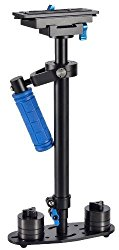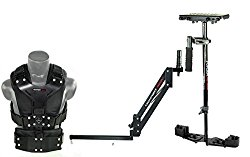How Do Steadicams Work?
 For anyone who knows anything about the history of filmmaking, they would know of the great value steadicams brought to the industry, and the artistic opportunities that arose from an accessory that would quickly be adopted as an integral part of filmmaking. Invented about half a century ago, these devices have held cameras steady for as long as color television has been around, ensuring stability even when moving, which was not something possible before the invention.
For anyone who knows anything about the history of filmmaking, they would know of the great value steadicams brought to the industry, and the artistic opportunities that arose from an accessory that would quickly be adopted as an integral part of filmmaking. Invented about half a century ago, these devices have held cameras steady for as long as color television has been around, ensuring stability even when moving, which was not something possible before the invention.
To simply put how steadicams work, you could think of it as a kind of selfie stick for professional filmmakers, adding convenience were badly needed, but with much greater practical and artistic application. The best way to show anyone how steadicams work, however, is by giving examples which would best illustrate their use and how that has affected the industry. I have selected the four best steadicams that should give one a good idea about their functionality.
If you are looking to get a steadicam, the following are two suggestions of two types of steadicams that I think would be ideal for your needs:
DVC Flycam Nano Camera Stabilizer
 When wanting to answer the question of how steadicams work, the DVC presents itself as a good start. It’s small, lightweight, easy to use, and it serves the purpose of holding a camera steady. Let’s explore in a little more detail its features.
When wanting to answer the question of how steadicams work, the DVC presents itself as a good start. It’s small, lightweight, easy to use, and it serves the purpose of holding a camera steady. Let’s explore in a little more detail its features.
Though it isn’t made for the largest of cameras, as the nano in its name may apply, this makes it especially useful for smaller cameras weighing up to 2kg. A cinematographer can hold this steadicam in his/her hand while moving about freely, never jeopardizing the stability of the image. It also has a platform that allows it to be set in a fixed place whenever a scene is not in motion.
Some important features that allow for the aforementioned stability when carrying the steadicam around are weight discs, fitted in a weight plate, which allows you to add and remove from the sixteen discs available. This allows you to balance cameras of different sizes on the stabilizer. The aluminum metal it is made of is given a soft grip so as to make it easier to hold for extended periods of time.
Overall, what the DVC Nano Camera Stabilizer does is steady the grip of cameras you would need to shoulder on, preventing blurs and shaky images with its design. Its convenience and light weight make it the best steadicam for cameras weighing less than 2kgs.
Opteka SteadyVid Camera Stabilizer
 The second of the same type of steadicam, the smaller and simple types, is the Opteka SteadyVid Cam Stabilizer. It has pretty much the same design as does the DVC, but it can carry cameras weighing just under 3kgs.
The second of the same type of steadicam, the smaller and simple types, is the Opteka SteadyVid Cam Stabilizer. It has pretty much the same design as does the DVC, but it can carry cameras weighing just under 3kgs.
It also has a great height adjustment, which can a great boost. We have talked about keeping the image steady, which this steadicam does just as well, but any cinematographer knows that there is added advantage in angling your camera from above or below. With the Opteka’s height adjustment, it allows you to do just that, along with all the other features you can expect from a steadicam.
Similar to the DVC, I thought this was a good pick as an alternative, not competition. The next two on the list will also be similar, but with slight differences.
Binko Stabilizer
 This one is a little more sophisticated, but given how many more camera options it supplies, rightly so. Supporting cameras that weigh up to 5kgs while still trying to keep the image steady can be a little tricky, and that is where the Binko Stabilizer steadicam comes in, allowing you to do just that while still staying in control as a cinematographer.
This one is a little more sophisticated, but given how many more camera options it supplies, rightly so. Supporting cameras that weigh up to 5kgs while still trying to keep the image steady can be a little tricky, and that is where the Binko Stabilizer steadicam comes in, allowing you to do just that while still staying in control as a cinematographer.
It comes with the usual stabilizer, much like the two steadicams above, but with added features. Most notable is the vest it comes with, which is fitted on the cinematographer, and holds and extra arms to support the weight. That way, the only thing the user has to worry about is moving the camera about, rather than actually carrying the weight, and that is also made easier by the dual arm that extends from the vest.
The entire piece is a single tool that works to make handling heavier cameras much more doable that if one were to try on their own. For all its sophistication in design, the Binko’s only purpose is to make life easier, and it does just that.
FLYCAM 5000 Camera System
 The FLYCAM 5000 is an alternative to the Binko stabilizer. They are similar in functionality, but there are some differences that give this steadicam its own advantage.
The FLYCAM 5000 is an alternative to the Binko stabilizer. They are similar in functionality, but there are some differences that give this steadicam its own advantage.
Its padded vest carries the same type of support arm, which keeps the camera steady, but also absorbs shocks and bumps which one may encounter on the move. The articulated arm also keeps the camera steady and supports the weight as it is expected to.
All the other usual features are to be found in the FLYCAM, such as the stabilizer and weights, but it also pretty lightweight itself, given all its functions. Add the functions of being able to fix it onto any number of surfaces and the height adjuster which allows you to angle the camera at different heights, and you have yourself a complete steadicam.
Conclusion
After reading through the list, one should be able to get not only a good picture of what a steadicam’s features are but the impact it has had in filmmaking. One cannot image all the car chases we are accustomed to seeing with such steady clarity without such a simple accessory as a steadicam.
If you are looking to purchase one for yourself, the four suggested steadicams above should serve your needs. I divided them into two categories so that you could have two options of each type. The first two are best for smaller cameras, providing you no more and no less than what you need to make a quality production and the last two are ideal for heavier cameras and more demanding scenes.
In any case, you should by now know how steadicams work and what the best one for your project would be.